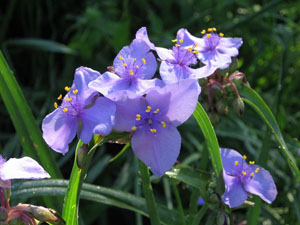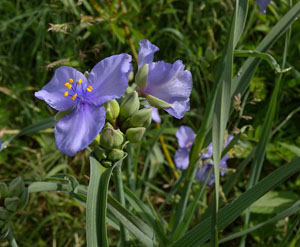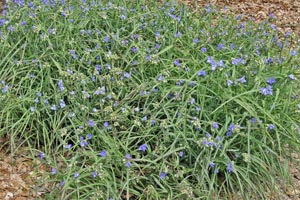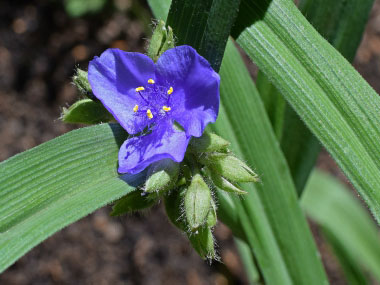





To support our efforts please browse our store (books with health benefits, etc.).
Spiderwort is a common wild plant that is also cultivated in gardens in many countries. There are approximately 70 species of this perennial plant, with the Virginia variety being one of the most common. Virginia spiderwort is native in most eastern areas of Canada and the U.S. It was introduced to Europe in the 1600’s as a plant to cultivate in gardens. For those living in the central area of North America it is important to be sure you are foraging for Virginia spiderwort; the Western variety (Tradescantia occidentalis) is a threatened plant in Manitoba, Saskatchewan, Alberta and 19 American states.
Distinguishing Features
Virginia spiderworts grow in erect clumps that can reach up to 60 cm in height. They have rounded stalks that are either single or branched at the base. This is a perennial plant that flowers (depending on location) anywhere from May to October. Seeds ripen between August and October and the flowers are generally a bright blue.
Flowers
The flowers are slightly fragrant, measuring 2 to 5.5 cm in diameter, and grow in terminal clusters. The three broadly ovate petals are generally bright blue but depending on various circumstances, they are sometimes violet, purple, rose, and (rarely) white. Individual blossoms are short-lived (one or two days), but new blossoms appear daily throughout the blooming period. These flowers are also hermaphrodite in nature.
 Fields
of Nutrition has medicinal benefits and vitamin/mineral content of Spiderwort.
Fields
of Nutrition has medicinal benefits and vitamin/mineral content of Spiderwort.
Leaves
Leaves are unique and tend to wrap around the stem. They are dark green (or olive) and can grow to lengths of almost 30 cm long and 2 cm to 3 cm in width. These leaves have smooth margins and parallel venation. Due to their length they often bend over at the middle, and they are linear to broadly linear, having a wide base and a narrow to pointed tip.
Height
This wild edible grows anywhere from 30 cm to 60 cm in height.
Habitat
Virginia spiderwort is found growing in woodlands, hillsides, stream banks, hillsides and in moist prairies. This plant prefers moist soil but tends to adapt to drier areas when need be. It also is found in pH balanced or alkaline soils, and prefers shady or part shade locations.
Edible Parts
Spiderwort had many uses in First Nation’s culture as food and medicine. The seeds are edible when roasted and ground into a powder (although they are somewhat bitter to taste). Leaves can be made into a tea or tossed into salads, soups, etc. The root can be collected all year round. The flowers can be tossed on top of a salad and eaten. (Dried, powdered flowers were once used as a snuff for nosebleeds.)
Externally, this plant can be used as a poultice to help heal wounds and hemorrhoids. Internally the leaves and roots are a valuable alternative medicine used by medical herbalists for their patients as an antidiarrheal, analgesic, anthelmintic, antiperiodic, astringent, diaphoretic, emetic, emmenagogue, expectorant, sedative, tonic, vermifuge, and vulnerary. Also, drinking spiderwort tea is supposed to be a good for increasing breast milk (Galactagogue).
Other Name
Virginia Spiderwort.
Winter Survival Food Handbook

PDF Plant Magazines
Types of Wild Food
Geographic Zones Seasons
Disclaimer
EdibleWildFood.com is informational in nature. While we strive to be 100% accurate, it is solely up to the reader to ensure proper plant identification. Some wild plants are poisonous or can have serious adverse health effects.
We are not health professionals, medical doctors, nor are we nutritionists. It is up to the reader to verify nutritional information and health benefits with qualified professionals for all edible plants listed in this web site. Please click here for more information.
Why Edible Wild Food?
- Food costs are rising
- Free, wild food is readily abundant
- Wild food adds nutrition to your diet
- Wild food can help treat various medical conditions







